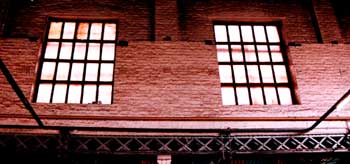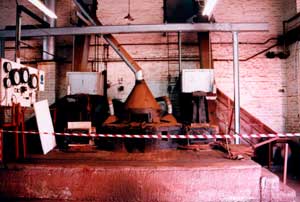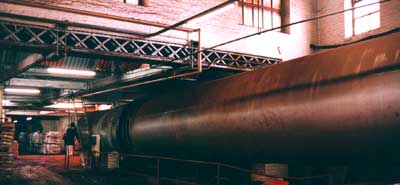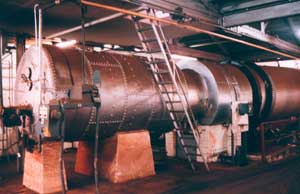|
 |
 |
 |
 |
 |
 |
 |
 |
 |
 |
 |
 |
 |
 |
 |
 |
 |
 |
 |
 |
|
|
|
|
 |
|
|
|
|
|
|
 |
With special thanks to Arthur Davis for his contribution to this page |
|
|
 |
In 1934 Abraham and Hertha Wreschner with their young sons Hans and Kurt joined the many hundreds of refugees leaving Germany to escape Nazi tyranny. Fearing for their future the Wreschners left their home in Berlin for the last time and came to Britain and eventually to Deanshanger. They bought the house named "Lodore" that had belonged to the Roberts' family and with the help of the London firm, Morris Ashby, who became partners, they acquired the old Roberts Iron Foundry and in its place founded the Deanshanger Oxide Works. |
|
 |
The new joint owners decided to make red lead initially, a scarlet crystalline powder formed by oxidising lead monoxide. This is the pigment used in paint and was in general use. However, because of its toxic properties in later years its use was confined to protective coatings for structural iron and steel work.
It was also very much used, especially in later years, in the making of high quality lead crystal glass and was sold to top glass makers and indeed formed a large part of the sales. The lead oxide made at Deanshanger was of the finest quality and was said to be the best in Europe.
The site was ideal, the canal ran along the north side of the area with a wharf on the site. In the early days coal was unloaded there for general use and the lead used in the process of making red lead was first brought by barge but soon this method of transport was made redundant by the use of lorries. The close proximity of the old A5 was to prove an asset right throughout the life of the works. |
|
 |
|
|
|
 |
|
|
 |
|
|
|
|
Windows in the red lead shop
Beneath them an unusual cross-braced and riveted steel beam can be seen. |
|
|
|
 |
The building chosen for the red lead was the old carpenters shop which had been used for making wood mould patterns for the old foundry. There was quite a lot of machinery powered by lineshaft turning pulleys with belt drives to pulleys on the machines shafts in this shop. A horizontal gas engine was the power unit. The gas used was coal gas made by a gas generator using bituminous coal.
The work force at the start consisted of half a dozen local men including one senior citizen Stan Barby still residing in the village. This small work force dismantled or broke up the machinery in the old carpenters shop and used part of it to build the red lead machinery using shafting, pulleys, bearings etc. This was the start of a practice used to great advantage, the buying of second hand and redundant equipment and repairing and modifying the same. Thus, plant which would have been scrapped was bought cheaply and for years, especially in the later iron oxide process, was turning out good quality material. Only in later years with the advanced technology arriving was expensive new plant bought.
|
|
 |
|
"Pig lead was so cheap at this time because it was bought over as "ballast" in ships!" |
|
|
|
|
"The Wreschners once bought so much pig lead that it cracked the floor." |
|
|
|
|
|
 |
 |
Pig lead was placed in the melting pots (the two square white tanks). Once melted it was ladled into the centre chamber (with the hood), which was known as the mill. It was mixed with oxide to form the "letharge" which was then sent to the calciner.
The photographs on this page were taken just after the red lead production ceased. |
|
|
 |
|
|
|
|
|
|
The lead was transported via a screw conveyor to a rotary calciner which transformed it into red lead. |
|
|
|
|
 |
|
|
 |
|
|
 |
This calciner proved the value of the buying of redundant plant. Though driven by old fashioned belt and pulley reducing gear it worked 24 hours per day with only 3 weeks maintenance stoppage per year and this from the start till the final close down. The calciner was made from a fabricated steel cylinder 4' 6'' approx. diameter and 40 to 50 feet long with insulating pads on the exterior. It rotated very slowly on very heavy rollers and sloped gently towards the delivery end. The small burner at the delivery used light oil and finally natural gas. |
|
 |
 |
 |
 |
Calciner, showing the gas burner in the right hand image.
|
|
 |
From the calciner the material was elevated to another storage hopper where the red lead was packed and stamped for sales purposes. This part of the plant was updated throughout the years with special attention paid to dust extraction, a Micropul dust plant being one of the innovations.
The plant began making red lead on a production basis in 1935
|
|
 |
 |
|
|
|
|
|
|
|
 |
Control panel for the red lead melting pots |
|
|
|
|
|
|
 |
Because of the toxic properties in lead even in the early days before tobacco was recognised as a health hazard the workers were not allowed to smoke because of the danger of lead being transmitted orally. The workers were examined at regular intervals by a visiting doctor and for the last 30 plus years workers in the red lead plant had regular blood tests and if any evidence of lead contamination was found the particular worker was found other work outside the plant. However, such cases were few and far between. Free milk was provided for each employee in later years to guard against lead poisoning.
The facilities for workers ablutions etc. as in most industries pre-war were very basic compared to later years. In later years the employees had modern toilet facilities, showers etc. and separate lockers for home and work clothes, this to prevent any possibility of lead particles being taken home. The overalls were provided by the firm were never taken home and were laundered privately. |
|
|
 |
Frequent inspections by specialists from what is now called Health and Safety Dept. very rarely found fault and never anything very serious. These inspections were made at times without warning . The plant was inspected at different times to the exhaust systems to atmosphere. The exhaust gases were never any great problem and the plant was often congratulated on its cleanliness.
It seems strange that this plant which ran so well for so many years with very little trouble and remarkably economical on manpower should summarily close down in 1991 and end a small but important part of Deanshanger Oxide works!
Back to Oxide Works: Contents Page |
|
|






